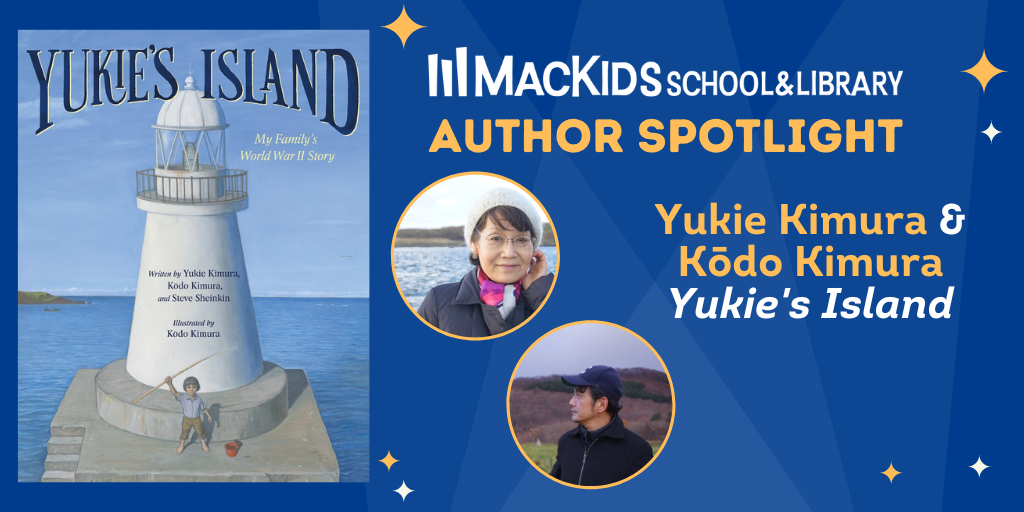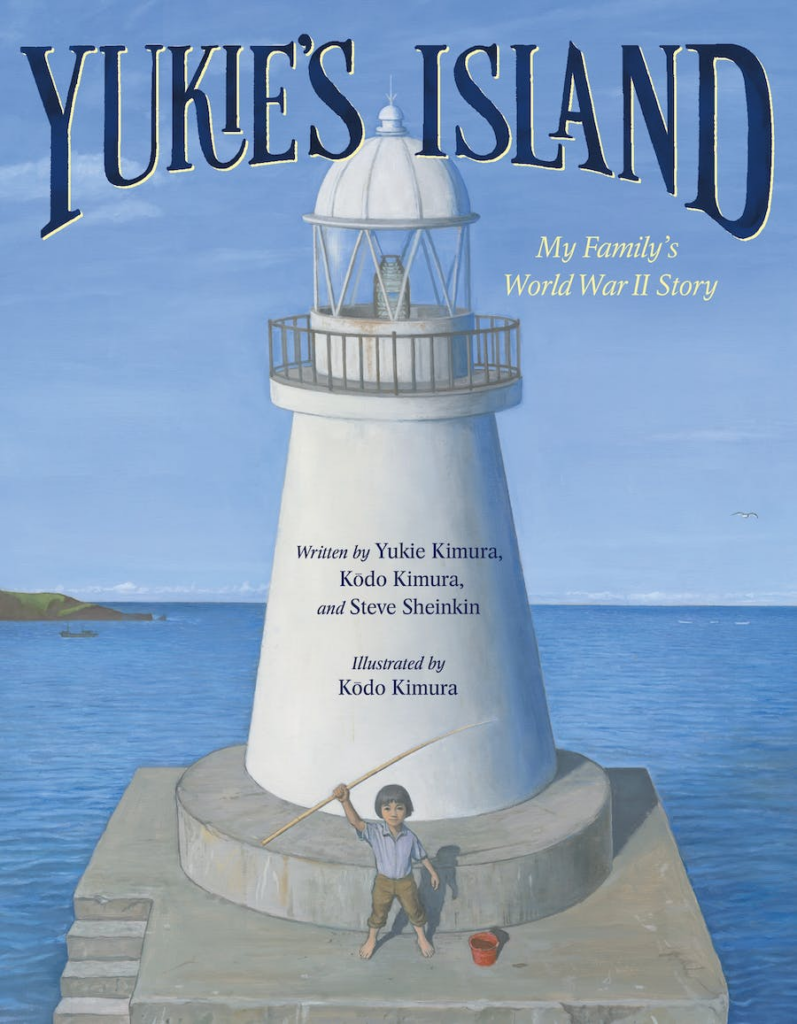
This month’s Author Spotlight highlights Yukie Kimura and Kōdo Kimura, co-authors with Steve Sheinkin of Yukie’s Island: My Family’s World War II Story, a moving picture book autobiography about a family’s resilience and path to healing after the devastation of war.
Kōdo, we love Yukie’s Island! How would you recommend teachers use this book in their classrooms?
Kōdo: I know that World War II can be a tough and challenging topic to introduce to young readers. At first glance, you might think the lifestyles and circumstances of American kids today and Japanese kids in the 1940s could not be more different. Even though eighty years separate children today with children growing up during World War II, they are essentially the same. They are still children – and human beings – who love their families, seek happiness, and who want to enjoy everyday life with their friends. If teachers can use this book as a tool for kids to bridge the gap in history and feel a kinship with children growing up during a very different time, I would be very grateful.
Wars like World War II affect all of our lives, including children’s lives, in a terrible way. This trauma isn’t just something in our past. The fallout from World War II is still impacting people’s lives everyday. I think books like Yukie’s Island might help us think deeply about other human beings and resist the urge to categorize them, especially as enemies. I want children to see that they could be Yukie. I want them to imagine how other people see the world. There are different viewpoints, different stories, and considering these different perspectives can help you better understand the complicated nature of reality. It is not a simple thing to connect with people you might find very different from you. That’s why all people have to work on it carefully – and together – before causing irreparable harm like we see in Yukie’s Island.
How did hearing your mother’s stories about the island and the war impact you as a young person?
Kōdo: My mother told me the story of her Island period many, many times when I was young. It was almost an adventure tale like Robinson Crusoe. Of course, the war and air raid parts of the story were scary, but I felt safe knowing that this happened a long, long time ago. I couldn’t imagine a similar thing happening again. What I didn’t realize then was that even as she was sharing her story with me, there were big wars and air raids happening all over the world and still happening today.
What was it like collaborating with Steve Sheinkin and your mother, Yukie, on this project?
Kōdo: It was beyond meaningful for me to work with my mother on a picture book about her life. She was very generous with how Steve and I chose to share her story and encouraged us to “play with it!” There are so many great episodes in her memoir with beautiful details, but we couldn’t possibly put all of them into the book. I translated my mother’s stories, historical references, documents, and information and then shared everything with Steve. He picked the episodes and restructured them amazingly. As we wrote in the author’s note, Steve is the person who saw the potential of my mother’s story and asked me to make it as a book. Without him, this book would not exist.
Tell us about a library, librarian or educator who made an impact on you as a child (or as an adult!).
Kōdo: Well, actually, I myself have been working for the college library in New York City for more than 25 years. I made all of the paintings for Yukie’s Island after work or during my holidays. So, I know a little about libraries and librarians!
The school library was always my favorite place at school, at least until I discovered the studio of the high school painting club. When I was in elementary school, I was especially into nonfiction about animals. I remember I really loved the work of Canadian-American author Ernest Seton. His fiction and nonfiction about wildlife were huge in Japan, I think way more so than in his country. I also enjoyed Joseph Kipling’s animal novels.
Yukie, in the afterword, Kōdo notes that you describe your memories as “sweet like jam.” What is the sweetest memory from the time you lived on the island?
Yukie: The details of everyday life are the sweetest memories for me. I recall my father jumping into his small boat to get fish for supper each night right before dinner time. His boat was never far from shore and would could talk to him as he fished for our dinner. He’d shout “How many fish do we need tonight?” We’d shout back “three or four!” I also clearly remember the day I learned to swim. I was on the rocky beach and I found the spot where lots of algae and seaweed grew thick. I laid down on it and suddenly found myself successfully floating with the help of the seaweed and took off from there! My parents saw me from the Island (they alway kept careful watch of the kids on the beach while working on the Island) and I heard them scream, “Yukie did it!” while clapping their hands. I remember that was one of the very happiest moments in my childhood.
What advice do you have for young people who might experience a scary event within their own life? How do you move forward?
Yukie: My feeling is that, generally, kids are resilient. From my personal experience as a young person, I remember playing with other kids was a very helpful distraction. Also, visiting kind neighborhood families and being welcomed and treated warmly was extremely helpful. Thankfully, I have many very kind family friends around me.
What was it like collaborating with Steve and your son, Kōdo, on this project?
Yukie: I was just talking about my memories, almost randomly. I didn’t see how these small episodes could become a book, so it was just amazing and exciting to see Steve and my son construct and shape my random memory fragments into a book.
Tell us about a library, librarian or educator who made an impact on you as a child (or as an adult!).
Yukie: Because of the war, my elementary school and middle school did not have a library. I imagine it was a very poor cultural situation for kids compared to the U.S.! I didn’t love my school experience so much, but did love my classmates, many of whom I am still good friends with 70 years later.
I remember I enjoyed Sunday School very much, which opened up after the war. It was a kind of bible school in the church. The minister (well, he was just a regular middle aged man) told us interesting stories and taught us Sanbika (hymns in Japanese). I enjoyed singing those songs with my friends so much, even though I don’t remember any of the stories.
What was your favorite book when you were a young reader?
Yukie: I was born right in the middle of wartime Japan in the section of the country that was farthest from the center of culture. So, unfortunately, there weren’t many books for children around me. My father had some books but because of his occupation, our family transferred often from lighthouse to lighthouse and he couldn’t keep many books for himself, either. Right after the war, a Japanese artist, illustrator, designer, and editor Jun’ichi Nakahara started publishing some magazines for women and young girls. I was really into one of them called “Himawari” (Sunflower). I couldn’t buy my own copy, but I would read my friend’s subscription. The magazine features many colorful illustrations and photos of beautiful fashions, etc., which were completely blocked in wartime.
ABOUT THE AUTHORS
ABOUT THE AUTHORS:

Kodo Kimura is a painter whose work has been exhibited in museums and galleries in the U.S. and internationally. Born in Hakodate, Hokkaido, Japan, he studied art in Tokyo and now lives in New York. Yukie’s Island is his debut picture book.

Yukie Kimura was born in 1937 on a tiny remote island in south Hokkaido called Matsumae Kojima. In 1943, her family moved to Bentenjima, where the events of this picture book take place. Since then, Yukie has become a skilled craftsman and dye artist, raised two boys, and started an herbal garden business with her late husband, Haruo Kimura. She currently lives in Date, Hokkaido, Japan.
ABOUT THE BOOK:

Yukie’s Island: My Family’s World War II Story
On Sale Now
A moving picture book autobiography about a family’s resilience and path to healing after the devastation of war.
It’s 1945, the final year of World War II. Yukie Kimura is eight years old. She lives on a tiny island with a lighthouse in the north of Japan with her family, and she knows that the fighting that once felt so far away is getting closer.
Mornings spent helping her father tend to the lighthouse and adventuring with her brother are replaced by weeks spent inside, waiting. At some point, Yukie knows, they may be bombed.
Then, it happens. One Sunday, bombs are dropped. The war ends soon after that. Everyone tells Yukie there’s nothing to be scared of anymore, but she’s not so sure. So she watches and she waits—until a miraculous sight finally allows her to be a kid again.
This is the true story of Yukie Kimura told in her own words, co-created with her son, illustrator Kodo Kimura, and co-written with bestselling Newbery Honor author Steve Sheinkin. Yukie’s Island is an honest, thoughtful, and stirring picture book about being a child living through wartime.


